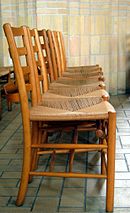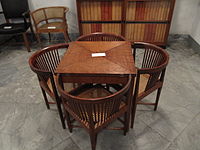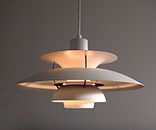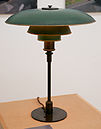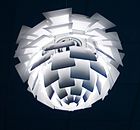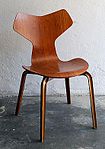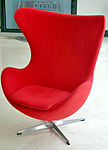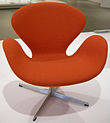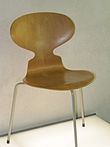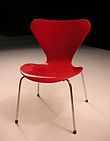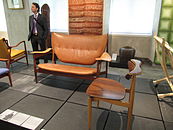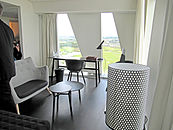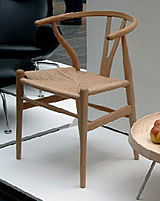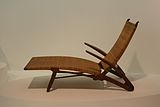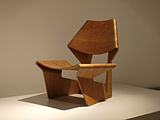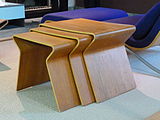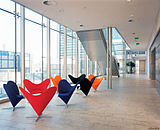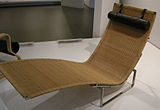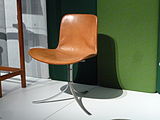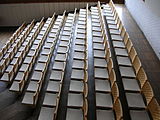- Danish modern
-
Danish modern, frequently capitalized as Danish Modern, is a vintage style of minimalist wood furniture from Denmark associated with the Danish design movement. In the 1920s, Kaare Klint embraced the principles of Bauhaus modernism in furniture design, creating clean, pure lines based on an understanding of classical furniture craftsmanship coupled with careful research into materials, proportions and the requirements of the human body. With designers such as Arne Jacobsen and Hans Wegner and associated cabitnetmakers, Danish furniture thrived in the 1940s, 50s and 60s. Adopting mass-production techniques and concentrating on form rather than just function, Finn Juhl contributed to the style's success, especially in the United States where there has recently been a renewal of interest.
Contents
Background
Between the two world wars, Kaare Klint exerted a strong influence on Danish furniture making. Appointed head of the Furniture Department at the Architecture School of the Royal Danish Academy of Fine Arts, he encouraged his students to take an analytical approach, adapting design to modern-day needs. Adopting the Functionalist trend of abandoning ornamentation in favour of form, he nonetheless maintained the warmth and beauty inherent in traditional Danish cabinet making as well as high-quality craftsmanship and materials.[1]
The development of modern Danish furniture owes much to the collaboration between architects and cabinetmakers. Cabinetmaker A. J. Iversen, who had successfully exhibited furniture from designs by architect Kay Gottlob at the Paris World Exhibition in 1925, was instrumental in fostering further partnerships. In 1927, with a view to encouraging innovation and stimulating public interest, the Danish Cabinetmakers Guild organized a furniture exhibition in Copenhagen which was to be held every year until 1967. It fostered collaboration between cabinetmakers and designers, creating a number of lasting partnerships including those between and Rudolph Rasmussen and Kaare Klint, A. J. Iversen and Ole Wanscher, and Erhard Rasmussen and Børge Mogensen. From 1933, collaboration was reinforced as a result of the annual competition for new types of furniture, arranged each year prior to the exhibition.[2][3]
In the postwar years, Danish designers and architects believed that design could be used to improve people's lives. Particular attention was given to creating affordable furniture and household objects that were both functional and elegant. Fruitful cooperation ensued, combining Danish craftmanship with innovative design. Initially the furniture was handmade but, recognizing that their work would sell better if prices were reduced, the designers soon turned to factory producion. Interest in Danish Modern in the United States began when Edgar Kaufmann, Jr. from the Museum of Modern Art purchased some items for the Fallingwater home designed by Frank Lloyd Wright.[4] This ultimately led to mass production in the United States too.[5]
The scarcity of materials after the Second World War encouraged the use of plywood. In the late 1940s, the development of new techniques led to the mass production of bent plywood designs by Hans Wegner and Børge Mogensen, both of whom produced chairs with a teak plywood seat and back on a beech frame. In 1951, Arne Jacobsen went even further with his sculptural Ant Chair with a one-piece plywood seat and back, bent in both directions. Collapsable chairs dating from the 1930s include Kaare Klint's Safari Chair and propeller stools which were also developed by Poul Kjærholm and Jørgen Gammelgaard.[6]
Finn Juhl's home in Charlottenlund just north of Copenhagen has been preserved as he left it with the furniture he designed. Other major contributors to Danish Modern include Mogens Koch, Verner Panton, Jørn Utzon, Hans J. Wegner and Grete Jalk. Examples of their work can be seen at Designmuseum Danmark in Copenhagen.[7] Of particular note are Mogensen's Sleigh Chair, Jacobsen's Swan and Juhl's sculptural wood-frame seats. One of Wegner's works was used by Nixon and Kennedy in a 1960 televised debate and is now known simply as The Chair.[8]
Main contributors
- Kaare Klint (1888—1954)
As a result of the furniture school he founded at the Royal Academy in 1924, Klint had a strong influence on Danish furniture, shaping designers such as Kjærholm and Mogensen. His carefully researched designs are based on functionality, proportions in line with the human body, craftsmanship and the use of high quality materials. Notable examples of his work include the Propeller Stool (1927), the Safari Chair and the Deck Chair (both 1933), and the Church Chair (1936).[9]
- Poul Henningsen (1894–1967)
Poul Henningsen, a self-taught inventor and true Functionalist, was an important participant in the Danish Modern school, not for furniture but for lighting design. His attempt to prevent the blinding glare from the electric lamp bulb succeeded in 1926 with a three-shade lamp, known as the PH lamp. The curvature of the shades allowed his hanging lamp to illuminate both the table and the rest of the room. He went on to design many similar lamps, some with frosted glass, including desk lamps, chandeliers and wall-mounted fixtures. Though he died in 1967, many of his designs have remained popular to this day.[10]
- Mogens Lassen (1901–1987)
In addition to his architectural work, Lassen was also a keen furniture designer. Influenced both by Le Corbusier and Ludwig Mies van der Rohe, he developed a unique approach to Functionalism.[11] As a result of his fine craftsmanship and his search for simplicity, his steel-based furniture from the 1930s added a new dimension to the modernist movement. His later designs in wood still form part of classical Danish Modern, especially his three-legged stool[12] and folding Egyptian coffee table (1940) originally produced by A. J. Iversen.[13]
- Arne Jacobsen (1902–1971)
Graduating from the Royal Academy in 1924, Jacobsen quickly demonstrated his mastery of both architecture and furniture design. With the completion of his Royal Hotel in Copenhagen and all its internal fittings and furniture in 1960, his talents became widely recognized, especially as a result of the chairs called the Egg and the Swan, now international icons. His stackable, three-legged Ant Chair (1952) with a one-piece plywood seat and back and its four-legged counterpart, the 7 Chair (1955), were particularly popular with worldwide sales in the millions.[14]
- Ole Wanscher (1903–1985)
Inspired by Kaare Klint under whom he had studied, Wanscher later followed in his footsteps as professor of the Royal Academy's furniture school. Particularly interested in 18th-century English furniture and in early Egyptian furniture, one of his most successful pieces was his delicately designed Egyptian Stool (1960) crafted from luxurious materials. Another successful item was his Colonial Chair in Brazilian rosewood.[15] He was awarded the Grand Prix for furniture at Milan's triennale in 1960.[16]
- Finn Juhl (1912–1989)
Though he studied architecture at the Royal Academy, Juhl was a self-taught designer as far as furniture was concerned. In the late 1930s, he created furniture for himself but from 1945 he became recognized for his expressively sculptural designs, placing emphasis on form rather than function, so breaking tradition with the Klint school. His successful interior design work at the UN Headquarters in New York spread the notion of Danish Modern far and wide, paving the way for the international participation of his Danish colleagues. Two key pieces of furniture, in which the seat and backrest are separated from the wooden frame, are his 45-Chair, with its elegant armrests, and his Chieftain Chair (1949).[17]
- Børge Mogensen (1914-1972)
After studying under Kaare Klint at the Copenhagen School of Arts and Crafts and at the Royal Danish Academy of Fine Arts, Mogensen adopted Klint's approach to simple, functional furniture design. Taking an almost scientific approach to an item's funtionality, most of his furniture is characterized by strong, simple lines and was designed for industrial production. Notable items include his oak-framed Hunting Chair (1950) with a strong leather back and seat, his light, open Spokeback Sofa (1945), and the low robust Spanish Chair (1959).[18]
- Hans Wegner (1914-2007)
After graduating in architecture in 1938, he worked in Arne Jacobsen and Eric Møller's office before establishing his own office in 1943. Striving for functionality as well as beauty, he became the most prolific Danish designer producing over 500 different chairs. His Round Chair (technically Model500) in 1949 was referred to as "the world's most beautiful chair" before being labelled simply The Chair after Nixon and Kennedy used it in a 1960 televised debate. His Wishbone Chair, also 1949, with a Y-shaped back split and a curved back and was inspired by a Chinese child's chair he had seen. A work of simplicity and comfort, it is still made today by the Danish firm Carl Hansen & Son. Wegner's designs can now be found in several of the world's top design museums including New York's Museum of Modern Art.[19][20]
- Grete Jalk (1920–2006)
After training as a cabinetmaker, she studied at the Danish Design School in 1946, while receiving additional instruction from Kaare Klint at the Royal Academy's Furniture School. Inspired by Alvar Aalto's laminated bent-plywood furniture and Charles Eames' moulded plywood designs, she began to develop her own boldly curved models in the 1950s. In 1963, she won a Daily Mirror competition wirh her He Chair and She Chair. With the help of furniture manufacturer Poul Jeppesen, she went on to design simpler models with clear, comfortable lines which became popular both in Denmark and the United States thanks to their competitive prices. Jalk also edited the Danish design magazine Mobilia and compiled an authoritative four-volume work on Danish furniture.[21][22]
- Verner Panton (1926–1998)
On graduating from the Royal Academy in 1951, Panton worked briefly with Arne Jacobsen. During the 1960s, he designed furniture, lamps and textiles with an imaginative combination of innovative materials, playful shapes and bold colours. Among his earliest designs were the Bachelor Chair and Tivoli Chair (1955), both produced by Fritz Hansen, but he is remembered above all for his Panton Chair (1960), the world's first one-piece moulded plastic chair.[23] Sometimes referred to as a pop artists, unlike the majority of his colleages, he continued to be successful in the 1970s, not only with furniture but with interior designs including lighting.[24][25]
- Poul Kjærholm (1929–1980)
In addition to an academic career at the School of Arts and Crafts and at the Institute of Design at the Royal Academy, Kjærholm always took full account of the importance of place a piece of furniture had in surrounding architectural space. Functionality took second place to his artistic approach which was centred on elegantly clean lines and attention to detail. Unlike many of his contemporaries, he worked essentially with steel, combining it with wood, leather, cane or marble. Kjærhom developed a close understanding with the cabinetmaker E. Kold Christensen who produced most of his designs. Today a wide selection of his furniture is produced by Fritz Hansen. Kjærholm's work can be seen in New York's Museum of Modern Art and the Victoria and Albert Museum in London.[26]
Other participants
Many other designers and cabinetmakers contributed to the Danish modern scene. Several worked in partnerships, including:[27]
- Tove and Edvard Kindt-Larsen (1901–1982), both students of Kaare Klint, working with contrasting materials[28]
- Peter Hvidt (1916–1986) and Orla Mølgaard-Nielsen (1907–1993), remembered for the Ax Chair (1950) and the X Chair (1960)
- Ejner Larsen (1917–1987) and Aksel Bender Madsen (1916–2000) working mainly with teak and rosewood
- Preben Fabricius (1931–1984) and Jørgen Kastholm (1938–2007), demonstrating originality with their Horseshoe Chair (1962)
A number of cabinetmakers also developed skills in design. They include:
- Jacob Kjær (1896–1957), famous for his FN Chair, who also produced the furniture he designed
- Frits Henningsen (c. 1900 – c. 1970), who designed models produced at his own workshop in Copenhagen[29]
Several other individuals made important contributions:
- Mogens Koch (1898–1992), remembered for his bookcases (1928) and folding chair (1932)
- Rigmor Andersen (1903-1995), a versatile designer, maintaining the strict traditions of Klint's furniture school.[30]
- Peder Moos (1906-1991), designed and built individual pieces on request, with his own special finish[31]
- Kurt Østervig (1912–1986), trained in Odense, designed furniture for ships and cinemas as well as for the home.[32]
- Helge Vestergaard Jensen (1917–1987), who produced the Daybed (1955)
- Hans Olsen (1919–1992), who experimented with materials and form, creating a number of items in his own distinctive style.[33]
- Nanna Ditzel (1923–2005), pioneering new materials and production techniques, also working with textiles and jewelry
- Poul Volther (1923-2001), remembered above all for his iconic Corona Chair.[34]
- Arne Vodder (1926-2009), a close friend and partner of Finn Juhl, his furniture sold particularly well in the United States.[35]
- Bodil Kjær (born 1932), architect and interior designer who created a successful series of office furniture in the 1960s.[36]
- Bernt Petersen (born 1937), notable for his small, light stool (1959) with beautifully shaped legs and for his seating in theatres and concert halls.[37]
The American market
From the beginning of the 1950s, American manufactuers obtained licenses for the mass production of Danish designs while maintaining high standards of craftsmanship. Later the designs were altered to suit American tastes and American parts were introduced to reduce costs. When Sears and Woolworth's entered the market, the Danes countered by producing new designs based on new materials. Sales peaked around 1963 but when American manufacturers introduced moulded plastic and wood-grained Formica as cheaper substitues, they started to decline in favour of Mediterranean designs which became popular in 1966.[4][38] There has however been a resurgence of interest in recent years. While the mass-produced works of Wegner, Juhl and Jacobsen are still in demand, collectors are increasingly turning to limited production items from these and the other designers. In the United States, while prices have increased, they are still at reasonable levels compared to similar items of new furniture. Licensed manufacturers have started reissuing key designs while others have used Danish Modern for inspiraton.[39]
The Danish furniture industry
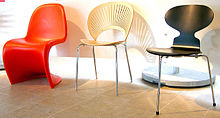 Danish Modern chairs at the Danish Design Center in Copenhagen
Danish Modern chairs at the Danish Design Center in Copenhagen
Employing some 15,000 people, each year Denmark's 400 furniture companies produce goods worth around DKK 13 billion (EUR 1.75 billion). A highly productive sector, over 80% of the furniture produced is sold aborad making furniture Denmark's fifth most important export industry. Most of the items produced are for the home but many are designed for the workplace. In addition to its classic designs, Danish designer furniture benefits from a new generation of innovative players. As a result, Denmark has maintained its place as the world's leading furniture producer in relation to the country's population.[40]
A number of firms continue to be active in producing both classic Danish Modern designs and in introducing variants designed by a new generation of artists. They include Republic of Fritz Hansen, Fredericia Furniture, Carl Hansen & Søn and Normann Copenhagen, all of whom exhibited at the 2011 Salone Internazionale del Mobile in Milan.[41] Other significant producers include PP Møbler, Kjærholm Production and One Connection, formerly known as Hansen & Sørensen.[42]
Innovative design work is also encouraged by the Wilhelm Hansen Foundation with the annual Finn Juhl Prize which is awarded to designers, manufacturers or writers who have made a special contribution to the field of furniture design, especially chairs.[43]
Cultural references
See also
References
- ^ Andrew Hollingsworth, Danish Modern, Gibbs Smith, p. 31.
- ^ Hollingsworth, p. 1
- ^ Carl Erik Andresen, Dansk møbelindustri 1870-1950, 1996, Århus: Systime, p. 84.
- ^ a b Kat DeLong, "Danish Modern Design For Today's Lifestyles", Lifescript, 2 June 2008. Retrieved 26 October 2011.
- ^ Morten Mandel Refskou, "BogFeature: Da danske møbler blev moderne", historie-online-dk. (Danish) Retrieved 25 October 2011.
- ^ "Exhibition", Danish-furniture.com. Retrieved 26 October 2011.
- ^ James Ruggia, "Copenhagen Design Week Highlights History of Danish Design", Travel Pulse, 20 September 2011. Retrieved 25 October 2011.
- ^ "The history of Mid Century Modern Design", Mid-Century Modern Online. Retrieved 25 October 2011.
- ^ "Kaare Klint", Danish-furniture.com. Retrieved 24 October 2011.
- ^ "Poul Henningsen", Danish-furniture.com. Retrieved 24 October 2011.
- ^ "Mogens Lassen", By Lassen. (Danish) Retrieved 29 October 2011.
- ^ "Mogens Lassen", galerie møbler. (French) Retrieved 29 October 2011.
- ^ Hollingsworth, p. 64
- ^ "Arne Jacobsen", Danish-furniture.com. Retrieved 24 October 2011.
- ^ "Ole Wanscher", Danish-furniture.com. Retrieved 24 October 2011.
- ^ Ida Haugsted, "Ole Wanscher", Kunstindeks Danmark & Weilbachs kunstnerleksikon. Template:Da icno Retrieved 27 October 2011.
- ^ "Finn Juhl", Danish-furniture.com. Retrieved 24 October 2011.
- ^ "Børge Mogensen", Danish-furniture.com. Retrieved 24 October 2011.
- ^ "Hans Wegner", Danish-furniture.com. Retrieved 24 October 2011.
- ^ David Colman, "Obituary: Hans Wegner, groundbreaking designer of Danish Modern furniture", New York Times, 6 February 2007. Retrieved 27 October 2011.
- ^ Søren Sass, "Grete Jalk (1920 - 2006)", Dansk Kvindebiografisk Leksikon. (Danish) Retrieved 8 November 2011.
- ^ Signe Brogaard, "Grete Jalk", Bo Bedre. (Danish) Retrieved 8 November 2011.
- ^ "Verner Panton", Danish-furniture.com. Retrieved 29 October 2011.
- ^ "Biography", Verner Panton, ëra. Retrieved 29 October 2011.
- ^ Hollingsworth, p. 58
- ^ "Poul Kjærholm", Danish-furniture.com. Retrieved 24 October 2011.
- ^ "Others", Danish-furniture.com. Retrieved 10 November 2011.
- ^ "Edvard Lindt-Larsen", Georg Jensen. (Danish) Retrieved 11 November 2011.
- ^ "Frits Henningsen", Denmark 50. Retrieved 10 November 2011.
- ^ Søren Sass, "Rigmor Andersen (1903 - 1995)", Dansk Kvindebiografisk Leksikon. (Danish) Retrieved 16 November 2011.
- ^ "Peder Moos", Antik&Auktion. Retrieved 10 November 2011
- ^ "Kurt Østervig", Gravsted.dk. (Danish) Retrieved 17 November 2011.
- ^ Bo Godt, "Klassisk, dansk møbelarkitektur", Bolikultur.dk. (Danish) Retrieved 16 November 2011.
- ^ "Poul Volther", Gravsted.dk. (Danish) Retrieved 16 November 2011.
- ^ "Arne Vodders tidløse klassikere", Rum, 4 April 2010. (Danish) Retrieved 16 November 2011.
- ^ Edith Rasmussen, "Når fortiden banker på", Livsstil.guide.dk, 24 March 2008. (Danish) Retrieved 19 November 2011.
- ^ "Bernt", Den Store Danske. (Danish) Retrieved 10 November 2011.
- ^ Sandy McLendon, "The Modern Mama Had Scandinavian Modern", Jetset. Retrieved 28 October 2011.
- ^ Hollingsworth, p. 10
- ^ "Danish furniture industry in short", Møbel+Interiør brancheforening. Retrieved 28 October 2011.
- ^ Jeppe Villadsen, "Hatched from The Egg", Denmark.dk. Retrieved 28 October 2011.
- ^ "Producenter", Mobelguide.dk. (Danish) Retrieved 28 October 2011.
- ^ "Ditte Hammerstrøm modtog Finn Juhl Arkitekturpris 2011", Ordrupgaard, 3 May 2011. (Danish) Retrieved 28 October 2011.
Literature
- Andresen. Carl Erik: Dansk møbelindustri 1870-1950, 1996, Århus: Systime, 157 p. ISBN 87-616-1265-0 (Danish)
- Greenberg, Cara: Mid-century modern furniture of the 1950s, 1984 (reprinted 2000), London: Thames & Hudson, 176 p. ISBN 0500278598
- Hansen, Per H: Da danske møbler blev moderne: historien om dansk møbeldesigns storhedstid, 2006, Odense, Syddansk Universitetsforlag, 644 pp. ISBN 87-11-23196-3. (Danish)
- Hansen, Per H.; Petersen, Klaus: Moderne dansk møbeldesign: tendenser, hammerslag og historie, 2007, Copenhagen, Gyldendal, 329 p. ISBN 8702061619 (Danish)
- Hollingsworth, Andrew: Danish Modern, 2008, Salt Lake City: Gibbs Smith, 240 p. ISBN 9781586858117
- Jalk, Grete: Dansk møbelkunst gennem 40 år - 40 years of Danish furniture design, 1987, Tåstrup: Teknologisk Instituts Forlag, 4 volumes: ISBN 8775117118, ISBN 8775117126, ISBN 8775117134 and ISBN 8775117142.
- Karlsen, Arne: Danish furniture design in the 20th century, 2007, Copenhagen: Christian Ejlers, two volumes: 328 p. & 223 p. ISBN 8772416777
- Wanscher, Ole (translated by David Hohnen): The art of furniture: 5000 years of furniture and interiors, 1968, London, Allen & Unwin, 419 p.
Categories:- Danish design
- History of furniture
- Modernism
- Danish modern
- Danish furniture
Wikimedia Foundation. 2010.


